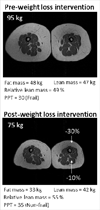Sarcopenic obesity: how do we treat it?
- PMID: 23974769
- PMCID: PMC4046899
- DOI: 10.1097/01.med.0000433071.11466.7f
Sarcopenic obesity: how do we treat it?
Abstract
Purpose of review: The increasing prevalence of sarcopenic obesity in older adults has heightened interest in identifying the most effective treatment. This review highlights recent progress in the management, with an emphasis on lifestyle interventions and pharmacologic therapy aimed at reversing sarcopenic obesity.
Recent findings: Whereas weight loss and exercise independently reverse sarcopenic obesity, they act synergistically in combination to improve body composition and physical function, beyond which is observed with either intervention alone. Optimizing protein intake appears to have beneficial effects on net muscle protein accretion in older adults. Myostatin inhibition is associated with favorable changes in body composition in animal studies, although experience in humans is relatively limited. Testosterone and growth hormone offer improvements in body composition, but the benefits must be weighed against potential risks of therapy. GHRH-analog therapy shows promise, but further studies are needed in older adults.
Summary: At present, lifestyle interventions incorporating both diet-induced weight loss and regular exercise appear to be the optimal treatment for sarcopenic obesity. Maintenance of adequate protein intake is also advisable. Ongoing studies will determine whether pharmacologic therapy such as myostatin inhibitors or GHRH analogs have a role in the treatment of sarcopenic obesity.
Conflict of interest statement
The authors declare no conflicts of interest.
Figures


Similar articles
-
Sarcopenic obesity.Hormones (Athens). 2018 Sep;17(3):321-331. doi: 10.1007/s42000-018-0049-x. Epub 2018 Jul 16. Hormones (Athens). 2018. PMID: 30014320 Review.
-
Sarcopenic obesity and complex interventions with nutrition and exercise in community-dwelling older persons--a narrative review.Clin Interv Aging. 2015 Aug 6;10:1267-82. doi: 10.2147/CIA.S82454. eCollection 2015. Clin Interv Aging. 2015. PMID: 26346071 Free PMC article. Review.
-
Sarcopenic obesity as a determinant of cardiovascular disease risk in older people: a systematic review.Postgrad Med. 2021 Nov;133(8):831-842. doi: 10.1080/00325481.2021.1942934. Epub 2021 Jul 12. Postgrad Med. 2021. PMID: 34126036
-
Sarcopenic obesity: strategies for management.Am J Nurs. 2011 Dec;111(12):38-44; quiz 45-6. doi: 10.1097/01.NAJ.0000408184.21770.98. Am J Nurs. 2011. PMID: 22082499
-
Sarcopenic Obesity: Epidemiologic Evidence, Pathophysiology, and Therapeutic Perspectives.Curr Obes Rep. 2019 Dec;8(4):458-471. doi: 10.1007/s13679-019-00359-9. Curr Obes Rep. 2019. PMID: 31654335 Review.
Cited by
-
The Role of Lifestyle Modification with Second-Generation Anti-obesity Medications: Comparisons, Questions, and Clinical Opportunities.Curr Obes Rep. 2023 Dec;12(4):453-473. doi: 10.1007/s13679-023-00534-z. Epub 2023 Dec 2. Curr Obes Rep. 2023. PMID: 38041774 Free PMC article. Review.
-
Effect of resistance training and protein intake pattern on myofibrillar protein synthesis and proteome kinetics in older men in energy restriction.J Physiol. 2018 Jun;596(11):2091-2120. doi: 10.1113/JP275246. Epub 2018 Apr 17. J Physiol. 2018. PMID: 29532476 Free PMC article.
-
Sarcopenia and Sarcopenic Obesity and Osteoarthritis: A Discussion among Muscles, Fat, Bones, and Aging.Life (Basel). 2023 May 24;13(6):1242. doi: 10.3390/life13061242. Life (Basel). 2023. PMID: 37374023 Free PMC article. Review.
-
An Assessment of Three Carbohydrate Metrics of Nutritional Quality for Packaged Foods and Beverages in Australia and Southeast Asia.Nutrients. 2020 Sep 11;12(9):2771. doi: 10.3390/nu12092771. Nutrients. 2020. PMID: 32932799 Free PMC article.
-
Stigma of obesity: A major barrier to overcome.J Clin Transl Endocrinol. 2014 Jun 18;1(3):73-76. doi: 10.1016/j.jcte.2014.06.001. eCollection 2014 Sep. J Clin Transl Endocrinol. 2014. PMID: 29159086 Free PMC article. No abstract available.
References
-
- Roubenoff R. Sarcopenic obesity: the confluence of two epidemics. Obes Res. 2004;12:887–888. - PubMed
-
- Villareal DT, Banks M, Siener C, Sinacore DR, Klein S. Physical Frailty and Body Composition in Obese Elderly Men and Women. Obes Res. 2004;12:913–920. - PubMed
-
- Kim YS, Lee Y, Chung YS, Lee DJ, Joo NS, Hong D, Song G, Kim HJ, Choi YJ, Kim KM. Prevalence of sarcopenia and sarcopenic obesity in the Korean population based on the Fourth Korean National Health and Nutritional Examination Surveys. J.Gerontol.A Biol.Sci.Med.Sci. 2012;67:1107–1113. - PubMed
-
- Zizza CA, Herring A, Stevens J, Popkin BM. Obesity affects nursing-care facility admission among whites but not blacks. Obes.Res. 2002;10:816–823. - PubMed
-
- Rantanen T, Harris T, Leveille SG, Visser M, Foley D, Masaki K, Guralnik JM. Muscle strength and body mass index as long-term predictors of mortality in initially healthy men. J.Gerontol.A Biol.Sci.Med.Sci. 2000;55:M168–M173. - PubMed
Publication types
MeSH terms
Substances
Grants and funding
LinkOut - more resources
Full Text Sources
Other Literature Sources
Medical
Research Materials

